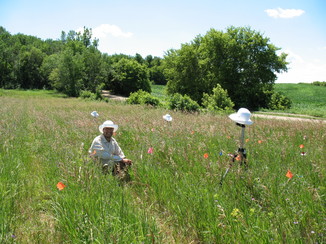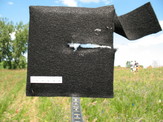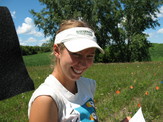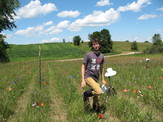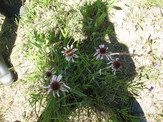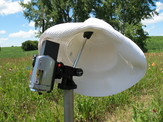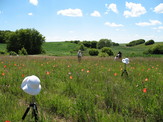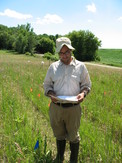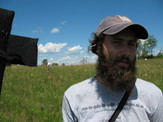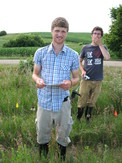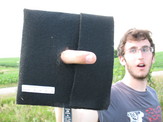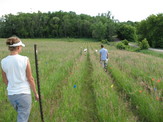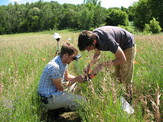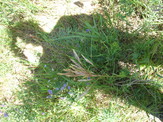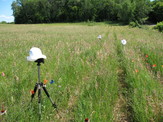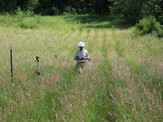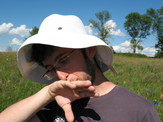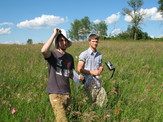|
|
We have gotten the chance to look briefly at some of the bee data that we gathered this summer. The first numbers that we have to report are the average flight distances that bees are making between plants. Average flight distance between different plants of Echinacea is 3.73 M. When we added the data for the flights between different heads on the same plant (these intraplant flights were all considered to be 0 M long) the average flight distance was shortened to 3.27 M.
In the next couple of days, we will potentially do the following with our data:
-construct a histogram to visually represent the distance distribution of flights
-print out the homerange maps for each bee, and determine their size, overlap with other homeranges, etc
-compare the maps of flight tracks to the phenology data to see if we can find patterns in which inflorescences bees are visiting and which they are choosing to ignore
-try to determine the percentage of flights that are not successfully transmitting pollen between compatible plants
A protocol for Team Video is in the early stages, and there are many aspects to consider. While it started slow, we have found a relatively quick and efficient system for placing cameras, taking down and storing cameras, and uploading videos. Unfortunately, many additional challenges await.
Watching the 2+ terabytes of footage will be a long and arduous task, and it is therefore key to plan well in these early stages. I believe the most important questions to ask at this phase are:
What data are we looking to collect?
With so much footage we have captured a lot of different things that we could potentially measure. We can see thrips on nearly every head we’ve recorded. We also have seen many ants, though typically of only two main species. Previous hypotheses about the roles of these ants have been posted, and the videos of the flowering heads would be a great resource for anyone wanting to find out more about them. As of now (though I’m not entirely sure as I haven’t thoroughly consulted with the rest of Team Video) I believe we are only going to record information about the insects that visit the heads and not their permanent residents.
What is the most effective/efficient way to collect these data?
This project cannot be done quickly or easily. Every day that we record in the Common Garden we get about 7-9 hours of footage per camera. With ten cameras rolling that is 70-90 hours of footage to watch per day. If we record for 5 days in a week (not uncommon) we then have 350-450 hours. That’s a freakin’ lot of video! Efficiency is key, but as a wise man once said “We’re looking to increase efficiency without losing accuracy”.
It is at these questions that I hit a wall, and would appreciate the input of my fellow bloggers/fans of the blog. As of now we have been using a video player that has the capacity to fast forward at speeds up to 32x, where should the line be drawn? At some point well below the 32x speeds, we might start missing things. Some bees only remain on the flower for a second or two before leaving, and the watcher of these videos may not catch these visits. However, there is really no way to watch these videos at normal speeds and expect to finish before the end of the decade (let alone the end of the summer). Also, a question directed at fellow Echinacea team members; are there data that you would like to be gathered from these movies that I haven’t mentioned? The ball has been passed into your court…
Good news for science at the Chicago Botanic Garden
The Daniel F. and Ada L. Rice Foundation is giving $8 million to help build a new science building. The 35,000 square-foot building will house laboratories for the Garden’s research team, classrooms, an expanded herbarium, a plant science library, and an enlarged seed banking facility. Read the detailed press release.
Kite Aerial Photography is not going well. Friday the 13th was a particularly bad day.
MORNING: In the morning Josh, Julie & I drove to NNWLF. We set out ground markers and got the kite up. After we got the camera up we realized that the remote control wasn’t going to gain us much with the canon S70 because it take about 10 seconds between shots in the RAW mode. The interval on the timer is about 15 seconds. Then the camera battery ran out ARG. So, we went back to lunch.
AFTERNOON: Armed with fresh batteries we went back to NWLF and set out the ground markers, got the camera up, and took a lot of shots. Or so we thought. When we returned I found that there were no photos on the card. We’re not sure what happened. Perhaps the LED didn’t trigger the sensor. The problem was we didn’t check. ARG.
EVENING: Julie & Josh painted the kite line at 10 meter interval, so we could gauge the height of the camera. When the paint dried, I went out the roll up the string and found it was in four pieces. Some animal had chew through the line in several places. ARG.
Well, we are learning a lot. We have a long way to go before we are a well-oiled KAP machine.
Of course there was a fine finish to the day. I was working on the computer and got distracted for a few minutes. Then I heard thunder in the distance and the power went off for a few seconds. I lost the first version of this lament. I then pulled the plug on all computers and went to bed.
|
|

